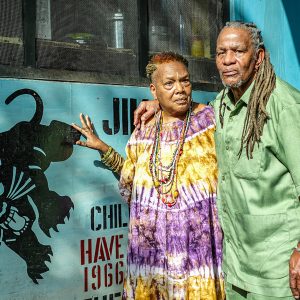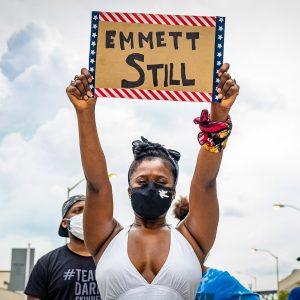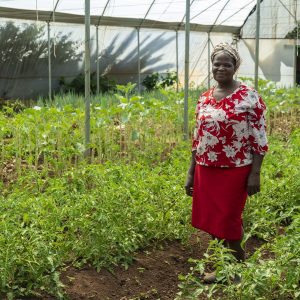Long Read | Part two: A Black Panther love story
Charlotte and Pete O’Neal fled the United States when he was targeted as a member of the Black Panther Party. Part two of their extraordinary story tells of their escape and long life in Tanzania.…
Author:
17 February 2021

More than half a century before a police officer would kill George Floyd, sparking mass protests, Black Panther Party co-founders Huey Newton and Bobby Seale understood that police brutality was the most immediate and pertinent concern for the Black community.
Their organisation was envisaged and established in the back room of the North Oakland Neighborhood Anti-Poverty Center, where Seale was employed in 1966. Charlotte and Pete O’Neal’s relationship was birthed and nurtured by the Black Panther’s evolution, from its moments of triumph to its downfalls.
Related article:
“Newton and Seale understood police brutality as an issue of dignity and disempowerment experienced by individuals,” writes Robyn Spencer in The Revolution Has Come: Black Power, Gender, and the Black Panther Party in Oakland. “For Blacks, hostile and violent interactions with the police were part of the fabric of daily life, and negative experiences with the police linked people across age, gender, and class.”
Panther members came from the military, gangs or had learned to use firearms to hunt, says Spencer. “In many ways, the panthers’ connection to armed self-defence was visceral … But if you came because of the guns, you also had to learn political education, and if you came for political education, you still had to learn how to use a gun.”
Soon after founding the group, Newton and Seale launched patrols to monitor police activity in Oakland and Newton learned the intricacies of the city’s open-carry gun laws.
The two would observe the police while they made arrests and intervene with cameras, tape recorders, legal books and licenced firearms. “The sight of two young black men, carrying guns, loudly asserting their rights to bear arms and warning the police not to be aggressors repeatedly drew crowds,” Spencer says.
“The idea of picking up a gun was very central because in a sense the gun was something that can be used for self-defence and it was something that had been racialised,” Spencer explains. “They saw the rights of gun ownership and the rights of self-defence as things that were historically denied to people of African descent. Those laws were made for white people and the Panthers took those same laws and repurposed them for a revolutionary end.”
Related article:
Emory Douglas, who acted as the minister of culture for the Black Panther Party, often designed caricatures of police officers as pigs in his drawings printed in the Black Panther newspaper, once again flipping the power dynamic between Black communities and the police.
“The Panthers replaced fear with action,” says Spencer. “The Panthers took police officers, which were these all-powerful authority figures, and transformed them into an image of a pig. Even in the way they used language, like ‘off with the pigs’, and how Emory Douglas and other Panther artists drew the police as pigs against a united community standing up and conquering the fear and moving into collective action, they were telling a story in a way that the people could understand that they actually had the power.”
When Californian authorities – in response to the Panthers’ armed patrols of police activity – tried to ban them from carrying loaded firearms, dozens of mostly armed members barged into the capitol in Sacramento in protest. This audacious stunt and the 1968 assassination of Martin Luther King Jr caused membership to swell.
Black Panther chapters opened across the US to address the needs of communities. The Panthers established education programmes and the Breakfast for Children Program, and set up free medical clinics with volunteer doctors and nurses. They saw their movement as part of a global class struggle and partnered with other organisations, including on the white Left.

One of the first programmes Pete O’Neal implemented in Kansas City gave free breakfast to children. At one point, they were feeding 700 children a day, says Pete.
The Kansas City chapter set up clothing and food distribution programmes and free health clinics with registered nurses. “The news media focused on one thing: ‘A Black man has a gun!’ But they didn’t want to talk about the beauty of our community [upliftment] programmes,” Pete says. “I was very proud of all of this and it was something I had never participated in in my life, something as grand and altruistic as this.”
‘Down for doubles’
The FBI created a counterintelligence programme in 1967 dubbed Cointelpro, which targeted Black nationalist organisations. Then director J Edgar Hoover said in 1969 that the “Black Panther Party, without question, represents the greatest threat to internal security of the country”.
The FBI flooded the organisation with informants and forged letters, correspondence and even cartoons to create or build on existing tensions between Panther members and their allies. Panther leaders, including Pete, had their phones and homes wiretapped illegally.
Agents from the Bureau of Alcohol, Tobacco and Firearms arrested Pete on 30 October 1969 for allegedly transporting a gun across state lines. About two weeks earlier, Pete and other Panther members had stormed a Senate hearing in Washington DC after receiving information about the Kansas City police confiscating guns and giving them to right-wing organisations such as the John Birch Society, the Ku Klux Klan and the Minutemen.
While he was already on the Kansas City police’s radar, after his arrest Pete began to fear for his life. “When I would go to court, the police would laugh while they were searching me. They would tell me, ‘When you go to jail, you’ll be on our turf and you’re coming out in a box,’” says Pete.
A Black officer warned Pete that the police were planning to kill him. “I knew he was telling the truth. I made my mind up in that moment that I was getting out and dodging.”

But Pete went to his trial and was sentenced to four years in prison. Despite already having a record, which included an escape from prison, the judge allowed him to stay out on his current bail agreement during the appeal process. “That was unheard of,” Pete says. “I think he knew I had a record of escape and thought it would be better if I just got out of their hair … I spoke out very strongly and continuously against police brutality. They didn’t want to make me, or anyone, a martyr and give us more power.”
Hoover had issued a directive under Cointelpro to “prevent the rise of a ‘messiah’ who could unify and electrify the militant Black nationalist movement”.
University of Florida professor and Black Panther in Exile: The Pete O’Neal Story author Paul Magnarella says there was “no justice” in Pete’s 1970 trial. It was riddled with “constitutional defects” that ensured the trial was “neither fair nor just”.
Pete knew he had to, but did not want to leave the US. “Charlotte was enchanted by the concept. But the idea of leaving the States sounded horrible to me,” he says. “But it was the best thing that ever happened to me … It’s funny how life works sometimes.”
The Left had what Spencer calls a “modern-day underground railroad”, people who could smuggle activists wanted by the authorities out of the US.
Related article:
The couple began planning their escape to Algeria, where Eldridge Cleaver, a prominent leader in the Black Panther Party, had launched the international section of the party after being charged with attempted murder and fleeing the United States in 1968. At the time, newly independent Algeria was a hub for anti-colonial movements around the world.
Charlotte and Pete could not tell their families about their plans. Charlotte remembers visiting her father at the station where he worked as a firefighter. “I was trying so hard not to cry. But we didn’t think we would be gone for long. Maybe two years.”
There was 24-hour police surveillance on their home, according to Charlotte, and they had to sneak out the back wearing disguises. Charlotte wore a wig, “looking all bourgeois”, she says, and Pete straightened his hair. The couple hid in the boot of a car until those helping them escape had crossed state lines.
They ended up in Long Island, New York, where “rich white communists” set up their documents and a lawyer drove them to the airport. Pete took Charlotte aside. “I told her that she didn’t have to go. She had gotten a full scholarship to go to medical school in Texas … You don’t have to do this,” Pete remembers.
Still a teenager, Charlotte’s response was confident: “No, brother chairman. I’m down for doubles. I’m with you all the way.”

A life of exile
The O’Neals spent several months with activists in Sweden before flying to Majorca, Spain, and from there to Algiers in Algeria. “When we got off the plane, we stayed in a bug-infested hotel,” Pete says. Not having an international contact, he took a leap of faith and asked the hotel owner for a number for the Black Panthers.
Pete spoke to Cleaver, but he was “very suspicious of me”. A bitter split had formed in the Black Panthers between Newton in Oakland and Cleaver in Algiers over the trajectory of the party. Newton said it should focus on community programmes, while Cleaver wanted to focus on the militant aspects and creating connections with international revolutionary movements. Newton eventually expelled Cleaver and the entire international section from the party, which led to spats of deadly violence between the Panthers and its dissidents.
These tensions were compounded by the FBI, which was wary of Cleaver developing international alliances hostile to the US, according to Spencer.
“I was worried about this split,” says Pete. “A lot of people died in the Black Panther Party because of this split. I gave Charlotte all the money that I had and told her, ‘If I don’t come back, get out of here and go back to Kansas City.’”

But when Pete arrived at the Black Panther Party’s office, he was greeted with open arms. “I felt like I had finally come home.” The Algiers office was a place where Panthers could meet and socialise with revolutionaries from around the world, from Vietnamese communists to Palestinian anti-Zionist fighters.
But relations between the party and the Algerian government began to disintegrate, exacerbated by two plane hijackings to provide the Panthers with hefty ransoms. The Algerian government intercepted both ransom payments and returned the funds to the US.
The Panthers, increasingly low on funds, publicly denounced the Algerian government, which cut the Panthers’ lines of communication and placed them under house arrest for six days. This, along with Algeria’s softening diplomatic stance on the US, was the beginning of the end of the international section of the Black Panther Party.
‘Pole by pole’
“When things began to fall apart in Algeria, I wanted to go back to Sweden,” Pete says. It was Charlotte who convinced him to consider Tanzania. Hundreds of African Americans were living there, including former members from the Kansas City chapter. “I took her advice and it’s the best advice I’ve ever been given.”
In 1972, the couple went from Algeria to Libya and then Egypt, where they were detained for not having a cholera vaccination card. Charlotte forged their yellow fever documentation to read cholera and the Egyptian authorities released them the next day.
“We had our honeymoon at a really nice hotel next to the Nile River,” Pete remembers, until they received their visas. The Tanzanian government welcomed them as “freedom fighters and political refugees”, says Charlotte.
“That was the last commercial plane I ever got on,” Pete says.
Charlotte was “overjoyed by the beauty” of Tanzania, he says. She “was excited and was looking at the colours and cloth. But it took a while for me to adjust. I grew up my whole life in the city and coming here, I saw the rusting tin roofs and I thought this was going to be hard. But slowly I got used to it. Now you couldn’t drag me out of here. I will be buried here.”
The couple lived in former capital Dar es Salaam for about a year. But the hot and humid coastal environment had adverse effects on Pete’s health, so they migrated inland and rented a home in Ngaramtoni village in the northern Arusha region.
Charlotte and Pete learned how to farm and became self-sufficient. They soon obtained four acres of land in Imbaseni, a quiet village about 25km from Arusha, where they live today.
Related article:
They recycled everything and Pete learned how to build windmills to provide electricity to the area. They raised chickens, milked cows, hunted and began farming beans and making sausages, which they sold for 15 years.
The O’Neals built a centre for children and teachers would congregate to offer classes. But Charlotte says its popularity soon rendered it too small and the daily trips to and from the city became a hassle. Pete and Charlotte decided to build a centre at their home.
“The first classroom was to teach computers,” says Charlotte. “We didn’t have the internet and it was those big giant computers with tiny little screens. And then the elders asked us to teach English and so we built another building for that. And it just kept growing after that.”
The couple founded the United African Alliance Community Center (UAACC) in 1991. The centre offers free classes in art, sewing, jewellery, yoga, ecology, hip-hop, music, photography and video production and editing.
Pete has not been able to return to the US, but Charlotte does speaking tours there each year to help raise funds for the centre.

One donor, former Black Panther Party member Geronimo Ji-Jaga Pratt, gave Pete and Charlotte $10 000 to help access water. He won a $4.5 million settlement for a wrongful murder conviction. Often referred to as “Papa Rage”, he lived in Tanzania for about 10 years with his wife and child before dying there in 2011.
“This drill company came here and … when they struck water, we had this big celebration,” Charlotte says. “The first thing we did was install a water tap so people wouldn’t have to walk for miles to get water. Later, we ended up helping to dig and erect 36 electricity poles. Now everybody [in the area] has access to electricity.”
Other former Panther members who have visited and contributed to the centre include Douglas, who gave art classes to the students.
A homebody and a grandfather
Pete and Charlotte established the Leaders of Tomorrow Children’s Home in 2008, which gives 28 disadvantaged children a home at the couple’s house, education and healthcare. These children have become part of their family. Malcolm and Ann Wood, the O’Neals’ children, are now in their 40s.
“I did not particularly believe in romantic love,” says Pete. “I was well travelled and well schooled in the university of life. I brought her [Charlotte] on her first plane ride. She was a child compared to me, but now it’s almost as if the roles have reversed. I stay home and take care of the children.” Charlotte has become the energetic one, making videos, movies and music with the youth in the area, while Pete has become the homebody. “I never thought I had a grandfather bone in my body. Now they hang out with me all day. At night, I have 20 children crowded in my bedroom … and I love it. This is what my exile has become.”

But decades later, Pete continues to experience post-traumatic stress from the police brutality he faced in the US. “If the police stop me on the road, they all know me. They wave and say, ‘Mzee [elder in Swahili], how you doing?’ But I still can’t help but feel nervous.”
The Black Panther Party finally crumbled in the 1980s. Relentless targeting by local authorities and the FBI led Newton to become increasingly paranoid and suspicious. He created an authoritarian atmosphere in the party and allegations of corruption and Newton’s drug abuse began piling up. In 1989, he was shot and killed on one of the same street corners of Oakland he had attempted to revolutionise. But Newton remains one of the most brilliant and well-respected minds of the black power movement.
Charlotte and Pete say they have continued the legacy of the Black Panther Party in Tanzania. “I’m a deeply flawed person,” says Pete. “I was then and I remain that way today. But my goal and aspiration is to try and be just a little bit better today than I was yesterday.
“I don’t always succeed. I backslide. But I hold on to this thought, philosophy and intellectual liberation I discovered back in 1968, and I continue to hold on to it dearly. And I think that will be my salvation. I’m not a religious person. But if I’m wrong and heaven exists, I’m going to get in there.”




